The perfect
production piano
The piano is the most played, recorded, and emulated instrument in the world, and finding the right one can be a challenge. Piano V aims to change that.
Distilling the most essential, experimental, and inspiring piano models into a single instrument, Piano V uses advanced physical modeling to recreate not just the perfect piano sound, but authentic mechanical and sonic behavior. Enjoy a full customizable piano studio right in your DAW.
Any type of piano
Warm classical, punchy hip hop, platinum pop, shimmering cinematic; from the timeless to the most outside-the-box piano concepts, Piano V’s 12 models cover an entire spectrum of ebony & ivory sound to breathe new life into your production, performance, and composition.
Ultra-real, no samples needed
Say no to heavy sample libraries and inconsistent sonic response - Piano V’s engine represents a real-time simulation of the physics and acoustics of a piano, guaranteeing consistency, authenticity, and flexibility that transcends the real thing.
Instant customization
More impact? Deeper harmonics? A wider sound? Any adjustments you need are no more than a click away. Piano V’s advanced engine gives you total control over the behavior of your piano - no tools or tuning forks required.
Studio included
Experiment with mic positions, immerse your piano in real acoustic space, and polish every aspect of your sound without ever leaving Piano V’s interface. This is a full production piano studio, fully equipped to slot the finest piano sounds seamlessly into your projects.
A priceless
line-up
Imagine having 12 customized spaces, each containing a different model of piano, surrounded by equipment to maximize its sonic potential.
Piano V brings these magnificent instruments to life in the virtual sphere like never before.
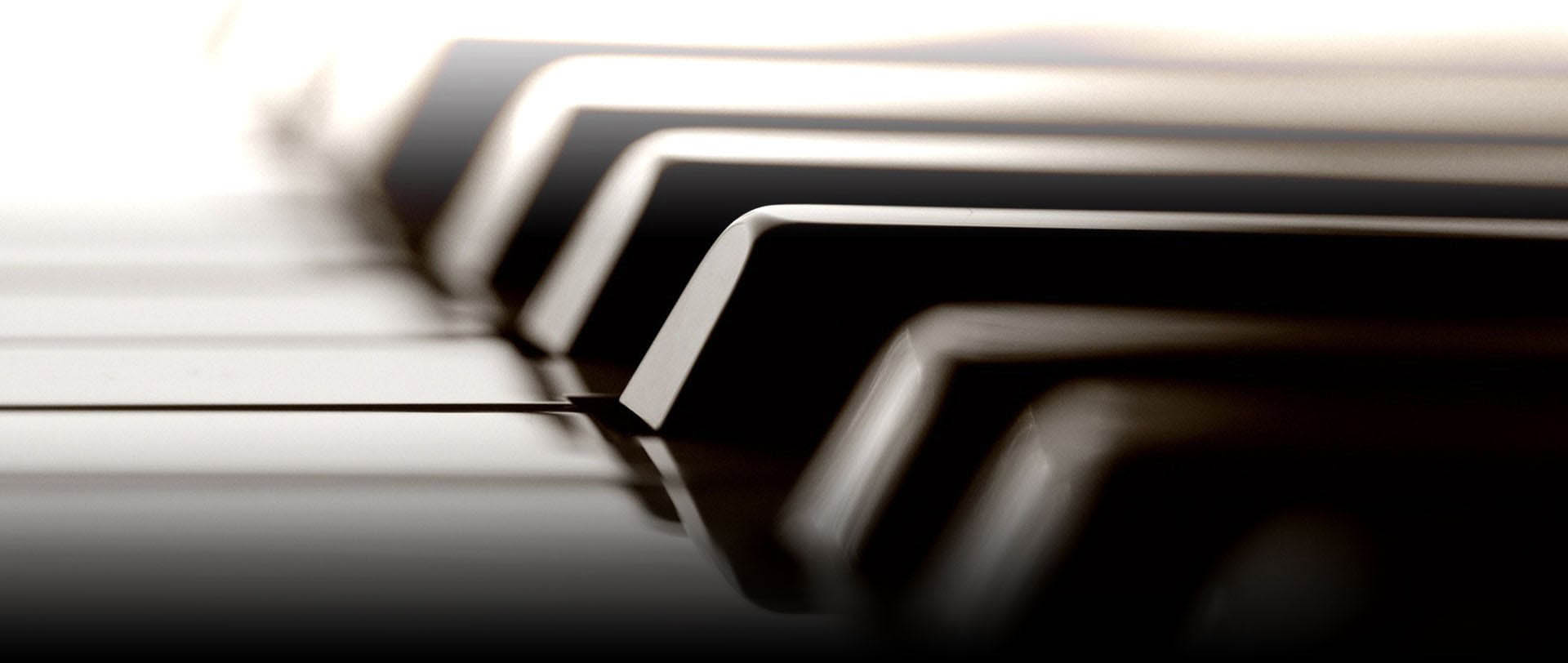
The universal
musical instrument
The piano isn’t just the most successful keyboard in history. It’s also the first velocity-sensitive one, with a sound so infectious it influenced literally every style of music.
Bartolomeo Cristofori (1655-1731) invented the piano as we know it. He called it the pianoforte, which translates as “soft loud.” It was hardly the first keyboard instrument — the organ and harpsichord came well before — but they played notes at more or less the same volume. Cristofori felt something was missing, and devised a hammers-and-strings action that allowed notes to speak not just louder but also harmonically brighter when played with more force. At first, the musical establishment said what they always say when new technology disrupts the status quo: “Meh, people won’t get it.” Like so many times before and after, they were wrong.
Discover the history of Piano
Phi:
Physical modeling
Our engineers recreate every aspect of the original instruments, down to the finest vibrations for a response that sounds and feels as tangible as the real thing.
Physical modeling uses mathematical models and algorithms to recreate the material reactions and unique interplay of both physical and electronic components. Its development has been pioneered since the ‘70s, with major breakthroughs from Stanford University in the USA and IRCAM in France opening the doors to exciting new methods and concepts.
It’s these breakthroughs that form the basis of Phi®, our exclusive physical modeling technology that allows us to perfectly mimic the resonant and mechanical behavior of an instrument. No details are left out of the equation, from the transient detail of the attack to the harmonic structure as the note releases; from the type of material the instrument is made of to the size and tonal properties of the room it was played in.
This provides a huge level of expression and finesse to musicians and producers, far exceeding the possibilities of sampling, and even the original instruments themselves.
Intuitive
control
Piano V’s main window gives you only the most essential controls you need to adjust your sound in real-time. Tweak, customize, and play uninterrupted.
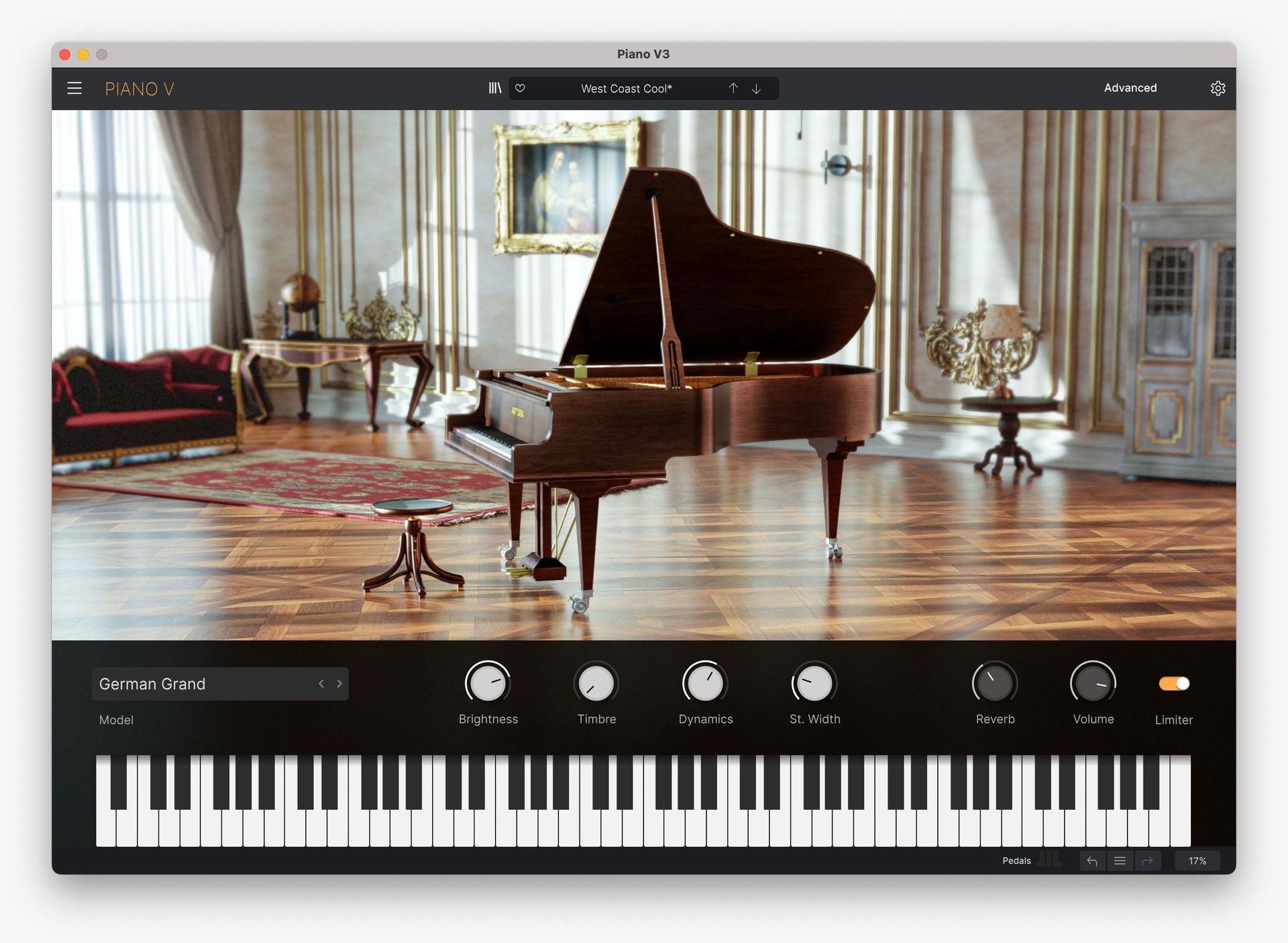
_1
_2
_3
01. Choose your model
Quickly switch between any of Piano V’s 12 models for quick comparisons, so you can hone in on the perfect piano for your project.
02. Refine your sound
4 versatile controls, 4 focused ways to change your sound in an instant. Find the perfect type of response, clarity, and character to suit your style.
03. Shape your space
Dial in whatever degree of ambience your piano needs with the Reverb control, from dry room space to drenched convolution reverb.
Your custom
piano studio
There’s often more to the final sound of a piano than meets the eye. Piano V’s Model panel takes you deeper into each instrument’s mechanical behavior, musical response, and even the mics used to record it. Impossible piano flexibility made effortless.
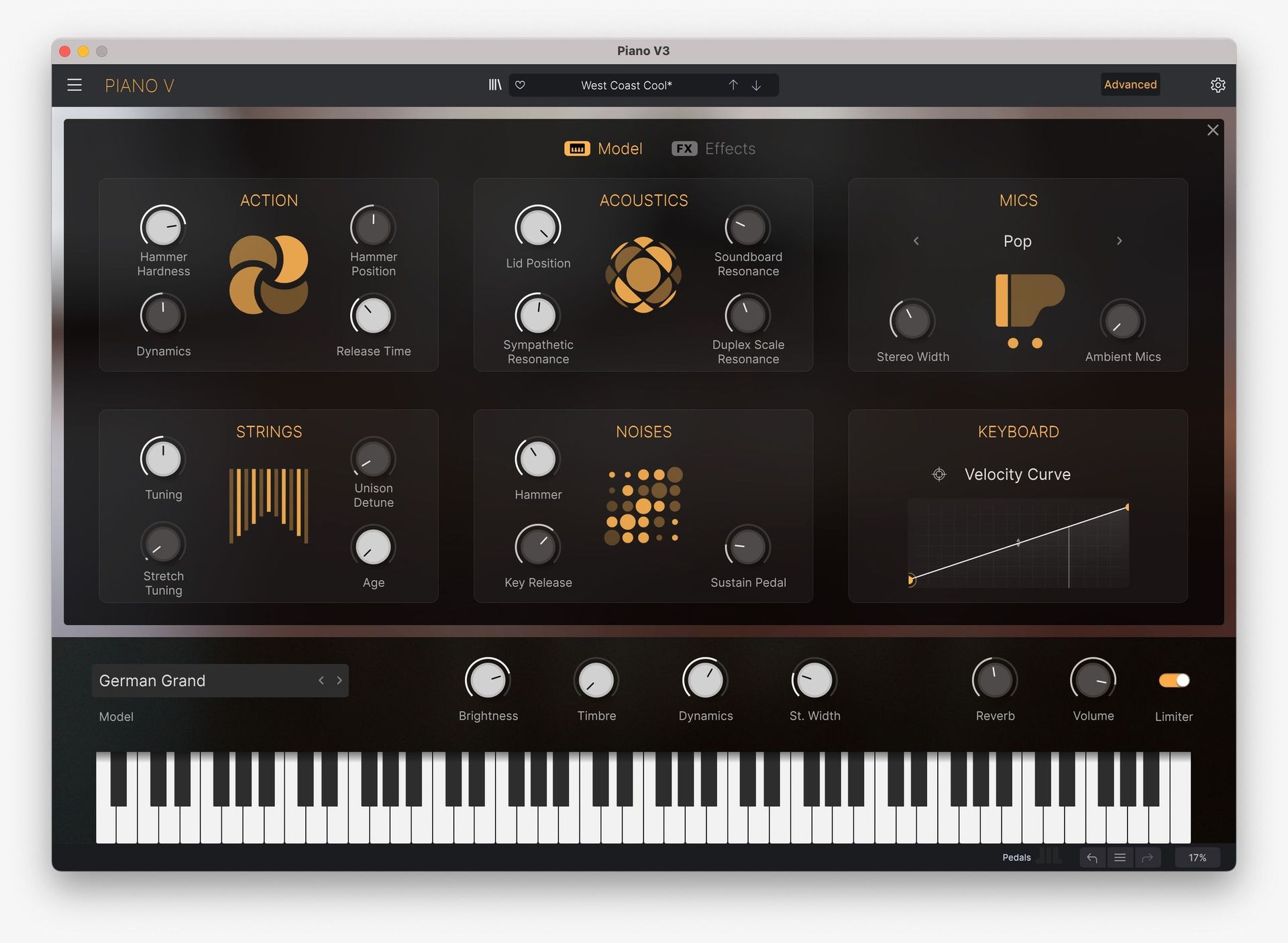
_1
_2
_3
_4
_5
_6
01. Action
Pianos are physical, kinetic instruments; Piano V allows you to go beyond the real thing by tapping into their mechanical behavior, from adjusting hammer action to refining their dynamic response. Create a piano action that’s truly your own.
02. Acoustics
Shape the projection and resonance of any of the 12 piano models to suit your performance or production. Lift the lid for a full sound, adjust the soundboard’s response, and even dial in Duplex resonance for colorful harmonic overtones.
03. Mics
Choose how your piano is captured by cycling through multiple mic configurations to suit any style, incorporate room sound into the mix for an immersive feel, and inject some extra stereo width for those cinematic chorus moments.
04. Strings
Tailor your piano’s tuning to maximize resonance, introduce dissonance, or create unique harmonic content to fit your mixes. You can even age your strings with a single click for that characterful worn-in sound.
05. Noises
The strings aren’t the only thing that makes sound on a piano. Dial in additional noise from hammers, keys, and pedals for that real instrument-in-motion feel.
06. Keyboard
Match Piano V to your playing style and calibrate it to match any MIDI controller simply by playing the way you play - Piano V does all the work. The world’s quickest and easiest velocity curve editor.
Effects
included
More than finishing touches, Piano V’s Effects section works in perfect harmony with its physical modeling engine to boost, sharpen, and sculpt your piano sound to its full potential.
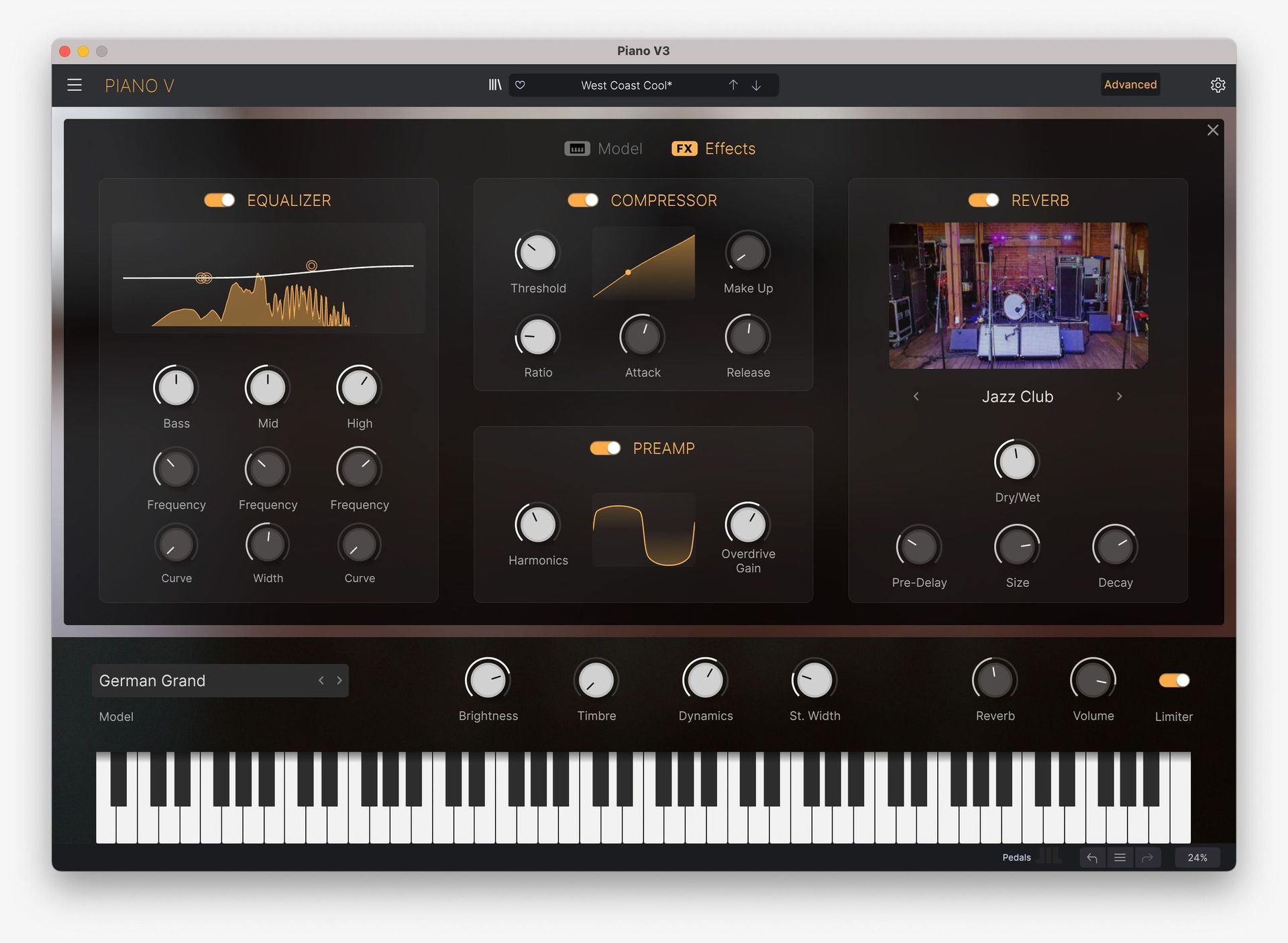
_1
_2
_3
01. 3-band Equalizer
Notch out troublesome frequencies or give the top end some air with Piano V’s precise 3-band parametric EQ.
02. Preamp & Compressor
Lift Piano V in a mix, dial in the perfect dancefloor stabs, or create an artificially cranked sound using the Preamp and Compressor from our proprietary Bus FORCE for whatever degree of heat and pressure your sound needs.
03. Reverb
Play Piano V inside virtual concert halls, clubs, studios, and other virtual acoustic spaces using a simple but state-of-the-art convolution reverb.
Artistscorner
Brian Kennedy
A higher level with Piano V
Cali-based Brian Kennedy has spent the best part of 20 years making a name for himself as an award-winning producer and songwriter to the stars. Like many of his peers, he often relies on his primary instrument - in this case, the piano.
Read the StoryHear it
in action
Before experiencing Piano V for yourself, check out these original sound demos to hear how it perfectly mimics a concert grand, a studio staple upright, and even a mythical plucked piano - you won't find these sounds anywhere else.
Black Forest
Beautifully ominous neo-classical piano piece showcasing the brand new Piano V3 physical modeling.
West Coast Cool
Contemporary jazz piece showcasing the Piano V3 upgraded physical modeling.
La Goutte D'or
Soulful and groovy modern track with the Piano V3 carrying the main riff and melodic variations.
West Coast Cool Grand
Voices
4 different V3 presets are combined in succession, each adding an additional harmony.
Creative Layers
Creative pianos are made when layering the Piano V3 with other Arturia VST's.
Arches
The Piano V3 is a versatile and dynamic modern instrument suitable for dance, jazz and many urban styles. This piece includes Pigments.
Preset
library
For when you need quick results, Piano V’s expansive preset library offers expertly-crafted sounds to cover every type of piano and every type of style - and then some.
The Big Easy
Joshua Fielstra
A sharp-toned piano at the back of the roadhouse ready for Zydeco, boogie, or jive.
Neglected Upright
Jerry Kovarsky
An aged upright piano that is slightly out of tune and uncared for, but not too far gone.
Romantic Piano
Jerry Kovarsky
A warm and mellow piano sound, perfect for solo playing.
Contraballet
Joshua Fielstra
A gentle but articulate tone ideal for neo-classical and minimalist pieces.
Chick Ish
Jerry Kovarsky
The German Grand shaped into a sound inspired by the late, great Chick Corea. Critical parameters to adjust are Hammer Hardness, Dynamics, and Hammer Noise.
Billys Boogie
Jerry Kovarsky
Emulating the sound of Little Feat's B. Payne in the late '80s to early '90s, this is more digital/sampled piano sounding than real acoustic.
Included in
V collection
Legendary Keyboards Reinvented
This instrument is also part of the V Collection -your complete dream line-up of the legendary synths, organs, pianos and more that made keyboard history. They’re modeled with the most advanced technologies for authentic realism, and enhanced with new creative options. Whether you use it as DAW plugins in the studio or standalone at gigs, V Collection puts the greatest keys of all time at your fingertips for instant inspiration.
Learn More
The features
you need

Integrated in-app tutorials guide you through every aspect of the instrument, from individual parameters to tips from our sound designers, so you can focus on the creative stuff. It shouldn't be this easy, but it is!

Arturia Software Center lets you download, organize, and update all of your Arturia software titles in one place, as well as manage all of your licenses across multiple devices. Keep it simple.

Our virtual instruments and plugins are designed to fit right into your setup without hassle. Whatever your style, you can explore sound while enjoying full compatibility with major DAWS, on both Windows and MacOS.

Instantly find the sound that’s in your head with intelligent & streamlined preset browsing. Search with keywords, explore by instrument type, musical style, and more - you can even save your favorites to quickly recall later.

Whether you want the full visual immersion of our classic instrument emulations, or to save precious screen real estate, the interfaces for all of your Arturia virtual instruments can be resized to a scale that suits you.

Instruments come seamlessly mapped for the Arturia KeyLab range - but they’ll place nice with other MIDI controllers too. Instant sound tweaking macros, easy DAW integration, and standalone operation.
Phi® Powered
State-of-the-art physical modeling designed to provide real material depth to our acoustic and electro-acoustic virtual instruments.
With advanced mathematical algorithms, our engineers recreate every aspect of the original instruments, down to the finest vibrations - for a response that sounds and feels as tangible as the real thing.
Learn more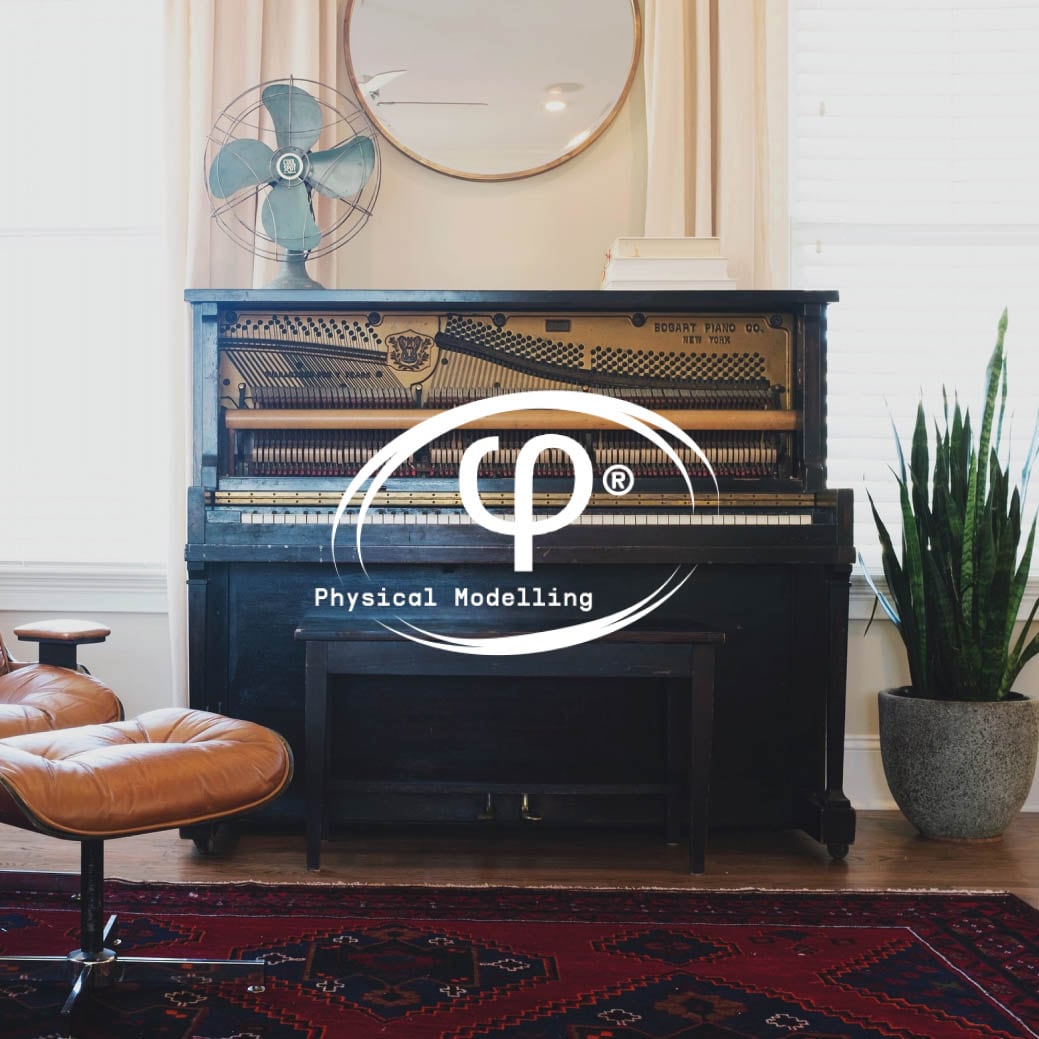
Gallery
Main Features
Virtual Instruments playable in a DAW (Live, FL Studio, Logic,...) or standalone with a MIDI keyboard.
Advanced Physical modeling engine (no samples needed)
12 different piano models to choose from
- American Grand
- German Grand
- Pop Grand
- Jazz Upright
- Piano-bar Upright
- Pop Upright
- Classical Upright
- Glass Grand
- Metal Grand
- Japanese Grand
- Plucked Grand
- Tack Upright
4 flexible macro controls for quick sound tweaking
Customizable mechanics and dynamics
- Hammer action
- String age
- Unison detuning
- Stretch tuning
- Dynamic range
- Lid position
- Soundboard, Sympathetic, and Duplex resonance
Velocity Curve editor to match your keyboard action
Multiple microphone positions
Customizable Mechanical noises
- Pedal Noise
- Key noise
- Hammer noise
MTS-ESP ODDSOUND microtuning compatibility
Platform specifications
Windows
- Win 10+ (64bit)
- 4 GB RAM
- 4 cores CPU, 3.4 GHz (4.0 GHz Turbo-boost)
- 3GB free hard disk space
- OpenGL 2.0 compatible GPU
- ARM processors not supported on Windows
Required configuration
- Works in Standalone, VST, AAX, Audio Unit, NKS (64-bit DAWs only).





Apple
- Mac OS 11+
- 4 GB RAM
- 4 cores CPU, 3.4 GHz (4.0 GHz Turbo-boost) or M1 CPU
- 3GB free hard disk space
- OpenGL 2.0 compatible GPU
Work with ASC
- An elegant and simple solution to help you install, activate, and update your Arturia software instruments.
All manufacturer and product names mentioned on this page are trademarks of their respective owners, which are in no way associated or affiliated with Arturia. The trademarks of other manufacturers are used solely to identify the products of those manufacturers whose features and sound were studied during the development. All names of equipment, inventors, and manufacturers have been included for illustrative and educational purposes only, and do not suggest any affiliation or endorsement by any equipment inventor or manufacturer.
*NKS ready








